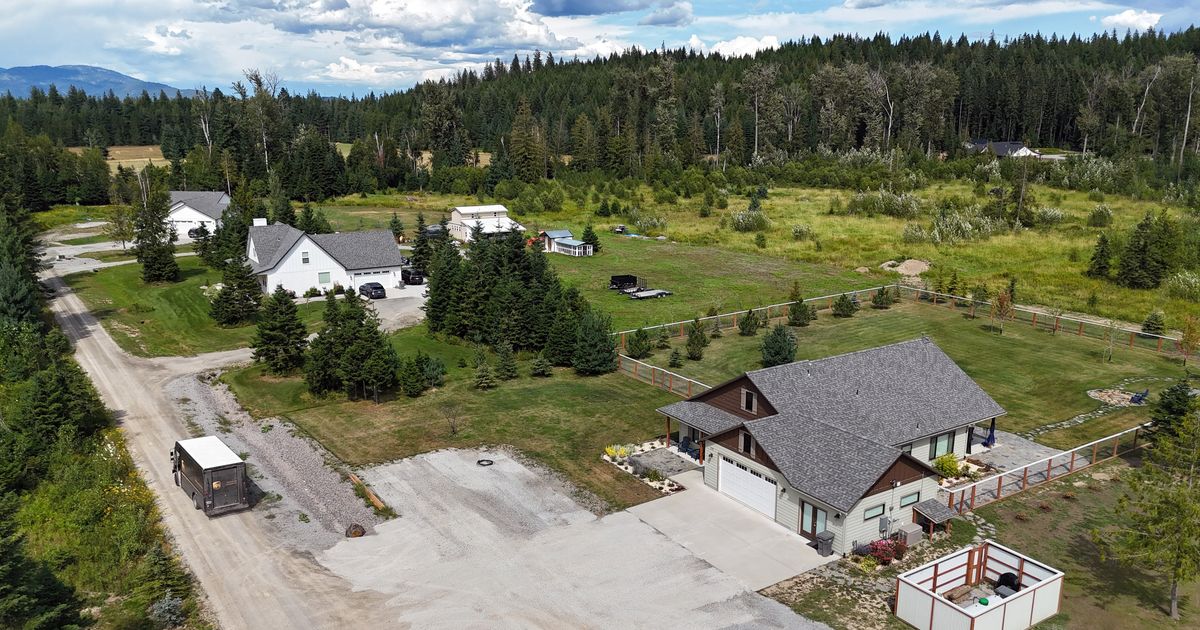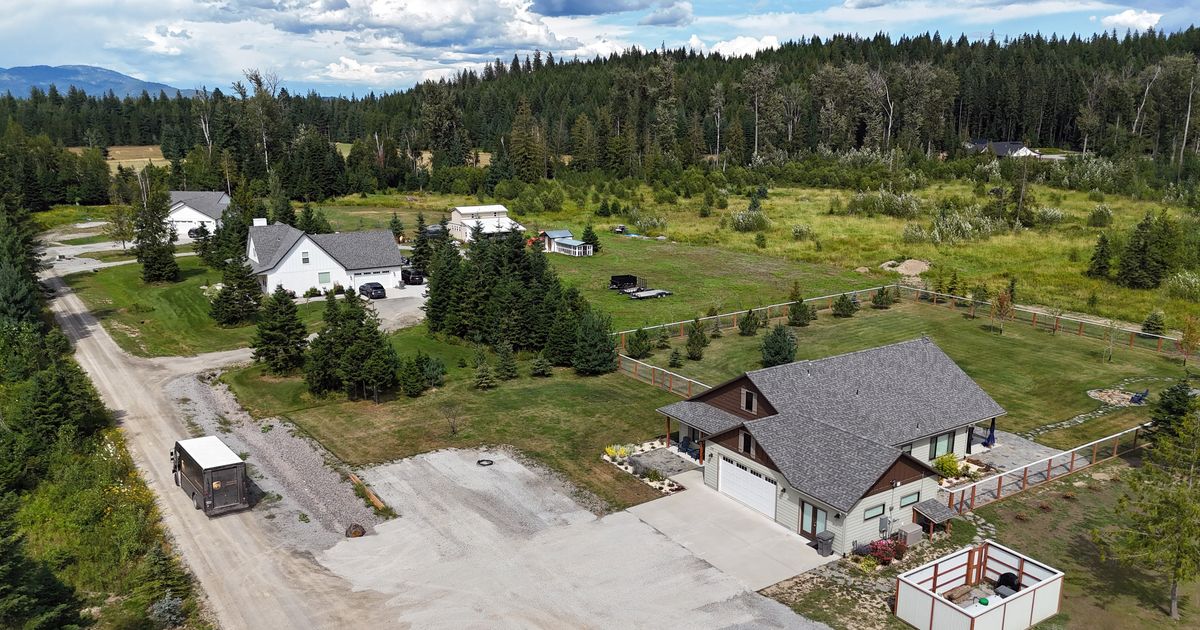
SANDPOINT – A man from San Diego thought in 2022 that he’d finally ended his five-year quest to find a second home that would eventually become his full-time residence.
The small Mountain Homestead subdivision, just north of Sandpoint, checked all the boxes for Lee Wilson: three bedrooms, close to Schweitzer Mountain ski resort and near Lake Pend Oreille.
It came on 4.83 acres, meaning that neighbors were near but not close.
But the 2022 purchase, which was north of $600,000, quickly turned into a financial calamity and ongoing paperwork nightmare.
The water turned out to be contaminated with E. coli bacteria, the property often floods because it was built on a wetlands, the community septic system doesn’t work properly and the homeowners later found out they probably don’t have a legal right to use the only road that serves as access from U.S. Highway 95.
“It’s been such a disaster,” said Wilson, who estimated that he’s spent more than $200,000 trying to mitigate the problems. “We didn’t feel like we had a choice but to participate in this and seek justice.”
After fighting the developers and Bonner County for answers, the neighbors went nuclear.
Four of the homeowners hired an attorney from Boise and last month filed a civil version of the federal statute that prosecutors often use to criminally pursue mafia bosses.
The civil suit, which names multiple parties, including former Bonner County commissioners and Realtors who marketed the troubled homes, falls under the Racketeer Influenced and Corrupt Organization Act. Those suits are better known as RICO cases.
“Defendants’ conduct has caused significant damage to plaintiffs and their property, including with respect to the flooding and expenses they’ve had to incur as a result of the issues with the drainage, septic tanks, wells, utilities, and roads,” the suit states.
“The ongoing saga borne of the plaintiffs’ tribulations with the development might have otherwise been chalked up to a series of unfortunate events had they not spent the last several years uncovering the widespread negligence, gross negligence, and outright fraud defendants have perpetrated against them,” the suit continues. “With this complaint, plaintiffs seek to shed light on defendants’ malfeasance and hold them accountable for what they’ve done.”
Josh and Jacob
Linda Wittwer, 65, originally of Santa Cruz, California, learned of Sandpoint five years ago by visiting North Idaho to inquire about a real estate listing.
The area reminded her and her husband, David, of their place in Lake Tahoe before that area basically outgrew itself.
The Wittwers came across Mountain Homestead in 2020 and agreed to purchase a home that still was under construction.
But this wasn’t her first dance with developers. Linda Wittwer said the Sandpoint home was either her eighth or ninth home purchase over her lifetime.
“I knew I had to be careful. You can only do so much due diligence,” she said. “We went to the county, the people responsible for making sure everything is done right.”
During her visit to the Bonner County Planning Department, she inquired about her home under construction at Mountain Homestead, located off of Logan Drive north of Ponderay.
“They said everything is fine. Everything is good,” she said.
The county planner told Wittwer that if she had any more questions to call either Josh Pilch, who at the time was a Bonner County planning official, or Jacob Marble, who currently serves as the chairman of the Bonner County Zoning Commission.
What the planning employee didn’t tell Wittwer was that Pilch and Marble were actually the owners of J&J Development LLC and developing the property where her home was being built.
Mountain Homestead
The 41 acres that were split up to make eight lots, each about 4.83 acres in size, had sat idle for more than 80 years because previous developers couldn’t overcome the issues with the ground, according to the suit.
A good portion of the land had been federally designated as a wetland. Neighbors who later purchased homes say that flooding during the spring runoff sometimes produces hip-deep water.
The ground also does not percolate well, meaning that Panhandle Health District would likely only approve a single septic system, according to the suit.
But Pilch and Marble trudged forth with a plan to hook all eight homes onto a single septic system as part of what’s called a “minor land development,” a process adopted by the county in or about 2017.
They also listed a 60-foot strip of land to the south of the development that would serve as an easement for utilities and a road access to U.S. Highway 95, according to plans. That easement for road and utilities was later found to have created an even more complicated mess.
But by developing the land as a minor land development, it meant only planning staff would review it.
The project’s septic system wouldn’t need, and didn’t receive, a final inspection from Panhandle Health. By using the minor land development process, it could be approved by the three-member County Commission on its consent agenda, without a formal public hearing.
It’s those kinds of shortcuts that prompted several community members to form Project 7B (the 7B stands for the Bonner County designation on Idaho license plates). The organization serves as a watchdog on developers and lets residents know about upcoming hearings for various projects, said Katie Botkin, who serves as executive director of Project 7B.
“Because our county has taken a very lax view of regulations, that basically has allowed developers to do a lot that they would not have been able to do in other counties,” Botkin said.
She explained that if a developer tried to build a subdivision in the city of Sandpoint, they would need to have signoffs from Panhandle Health, fire officials, the water department, road officials who would request traffic studies and all that information would be presented at a public hearing before a planning commission or hearing examiner.
Only then, with approval, would it go before the county commission for a final vote.
A minor land development, however, is reviewed by planning staff and goes directly to the county commission.
For example, in 2022 current Bonner County Planning Director Jake Gabell submitted his own development as a minor land development on 6.5 acres he owned on Wood View Road, which put his own staff in the position of regulating their own boss’ project.
The former county commissioners, Steven Bradshaw, Jeff Connolly and Daniel McDonald, who are all named in the Mountain Homestead suit, approved Gabell’s subdivision in a 3-0 vote, according to county records.
Since then, voters elected two new county commissioners and a third has been appointed to replace Bradshaw, who moved to Texas. The current board in May placed a moratorium on new minor land developments like the one used in Mountain Homestead, Botkin said.
“Obviously our organization, as well as many people in the county, are strongly encouraging the county to completely do away with them because they do allow for the abuse of the process,” she said. “I think it would be too difficult to fix all the loopholes. This lawsuit is bringing up things that we have been saying for a long time.”
She noted that current Commissioner Ron Korn said in a public meeting that Idaho is a “buyer -beware” state. But most home buyers don’t expect to pay thousands of dollars to hire contractors to check on systems after the purchase.
“Bonner County is very right leaning,” Botkin said. “But there are a lot of people who are in favor of smart regulations. The staunchest property rights advocate does not want to drink their neighbor’s poop.
“There are certain regulations that provide checks and balances that everyone wants for themselves and their neighbors.”
The water
Wittwer said she had the house inspected in 2020, which passed, and the county issued what’s called a certificate of occupancy. That means the county has signed off on all the things necessary for the homeowner to begin living in the home.
Wittwer said she initially was going to use the home in Mountain Homestead as a rental, but her son moved in and immediately noticed that the water was stained a muddy color.
“My niece stopped by with her family. They wouldn’t have their kids take a bath because it was so murky brown,” Wittwer said.
Wilson, the neighbor, said the communal wells have tested positive for E. coli bacteria on several occasions.
“The water is like brown. It’s not just silty. It’s dirty water,” Wilson said. “It’s also tested positive for arsenic. The issues just go on and on.”
After Wittwer’s son began having chronic rashes from bathing in the water, she invested about $10,000 in a filtration system. In fact, three of the four owners talked about going together to purchase filtration for the entire system.
But the well is located on land owned by a neighbor who has been uncooperative and threatened to cut access to it, according to the suit.
“Buyer beware” of septic
According to the suit, Pilch Custom Homes in 2019 installed the central-septic drain field and piping to serve all eight properties and submitted drawings of the septic system to Panhandle Health.
But Pilch, who did not respond to a message last week seeking comment, apparently buried the system before it could be inspected.
For the neighbors, alarming problems began almost immediately.
Wilson, the neighbor, noted: “People have filmed raw sewage flowing down the street in our community.”
During the spring melt, an alarm inside the septic system, designed to alert the neighbors of problems, began to send signals.
“It goes off consistently,” Wittwer said. “The managers at the time didn’t want us to look at it. They told us, ‘It’s just calibrated wrong.’”
Finally, after Wittwer became manager of the system, the neighbors had the septic tanks inspected in 2024.
“The septic company came out and took a look at it. They said it’s too far gone. It needs to get fully re-engineered,” Wittwer said. “But we were not able to get it in writing from the septic company. Our hands just got tied right and left along the way.”
Wittwer wrote letters to officials at Panhandle Health about why they approved a septic system that was already failing. The simple answer she got back was, they didn’t.
In letters filed as part of the suit, Jason Peppin, the environmental and health protection division administrator at Panhandle Health, explained that his agency did not have any role in approving the septic at Mountain Homestead.
“Prior to 2017, we would have been asked to review” the home locations and septic systems, Peppin wrote in part. “These are standard requirements in other counties of Idaho and had been in place in Bonner County for decades to prevent situations like this from happening.”
Peppin, in his letter to Wittwer, explained the differences between regulations in Idaho and most other states.
“A major difference between the rules for septic systems in Idaho compared to other states is that there is also no requirement for disclosure or verification of compliance with the rules when properties are sold,” Peppin wrote. “In this regard, Idaho operates in a ‘buyer beware’ system that places the responsibility of due diligence on buyers and their representatives (realtors, etc.).”
He noted that the septic system installed at Mountain Homestead was “installed deeper than required.” But even if Panhandle Health could prove the tank was installed too deep by a licensed installer, the only recourse the agency had was to revoke their septic installer’s license, Peppin wrote.
He continued that he discussed the Mountain Homestead issues with other state regulators and the Idaho attorney general. “They have confirmed that it is the responsibility of the property owners to resolve the issues,” he wrote.
Those answers, of course, left the homeowners feeling they had few options.
“There are so many people involved,” Wittwer said. “It’s a buyer -beware state but I don’t understand what more a buyer has to do to make it right.”
Road war
Along with the nonworking septic and stained and contaminated water, the neighbors uncovered yet another problem: They probably don’t have legal access to Logan Drive, which connects the homes to U.S. Highway 95.
According to the lawsuit, when Pilch and Marble carved up the lots, nobody at the county did the simple math to show that the subdivision also carved out about 2 acres of land that the attorneys contend was an illegal fifth lot.
“While it may seem at first blush an inconsequential oversight, allowing J&J to carve out the land comprising Logan Drive would prove to be disastrous for the (Mountain Homestead) homeowners,” the suit states.
“Indeed, as plaintiffs have now discovered, J&J’s motive in creating the fifth lots was not to remedy issues with access and utilities, as it claimed; rather, it was to surreptitiously sell Logan Drive to a third party who needed access to develop land in the area – land that J&J itself had sold to her along with Logan Drive.”
In 2018, Marble and Pilch obtained a quote from Woods Crushing and Hauling to build Logan Road to access the homes. The estimate came in at about $400,000 to build the road to Idaho Transportation Department standards.
“J&J apparently opted to build the road itself,” according to the suit. “The first major problem with Logan Drive is that J&J built it in the incorrect location, which happens to be partially on top of a third-party homeowner’s driveway.”
In fact, rather than building a new road, it appears the developers simply extended the homeowner’s existing driveway. The developers “did this when the (property owners) were out of town and without the (homeowner’s) permission,” according to the suit.
Only in 2023 did the Idaho Transportation Department learn that Logan Drive had been built.
“ITD has expressed confusion as to why it was never involved with the approval of” the subdivision, according to the suit.
To this day, the sign for Logan Drive is 27 feet north of its current location. It was placed by state crews to note where the road should have been built.
The neighbors started noticing heavy trucks using Logan Drive and inquired as to their use.
The neighbors learned that Pilch and Marble sold the easement for Logan Drive and the land behind Mountain Homestead to Ruth Barbey, who apparently wants to build 64 homes on the land next to the subdivision.
“On top of the significant and unresolved issues with the construction and placement of Logan Drive, (the neighbors) also do not have clear rights to use the road at this time because J&J sold it to defendant Barbey without their knowledge or consent,” according to the suit
Search for answers
When the full scope of the issues began to reveal themselves, the homeowners started asking questions of the county.
“Over the past several years, plaintiffs have zealously sought information from Bonner County to help them untangle the web of fraud and misdeeds defendants have weaved,” the suit states.
To that end, homeowner Michael Williams submitted a public records request to Bonner County in 2022. In response, county officials sent him a thumb drive that he thought contained the files he requested.
The thumb drive was empty.
“When he informed Bonner County of this fact, they replied that they had no information to share with him in response to his request,” the suit states.
Wittwer, the other neighbor, said she also requested documents. She got back two pages.
“It’s such a complex, convoluted thing with layers of cover-up,” she said. “The answers, when we were able to get them, didn’t make any sense.”
Lee Wilson, the other neighbor, said dealing with all of the problems has taken up most of his time for two years.
“The first year was just trying to talk with the county and make public records requests,” he said. “They have been uncooperative at best and fraudulent at worst.”
He said the homeowners finally found a trove of documents from an unlikely source: the small city of Ponderay.
Because of its proximity to the subdivision, Ponderay officials were provided many of the development documents.
“From them we started to discover all the things Bonner County was hiding from us,” Wilson said. “I honestly didn’t know about these issues. They keep revealing themselves like an onion. Financially, it’s been devastating.”
Wilson said he could have just retreated.
“I could try to sell it to someone else and not tell them, or do what we are doing,” he said. “We are trying to mitigate the issues and trying to get it fixed.
“The thing that really surprised me is the insider culture of the local government. It blew me away that the developers of the community could be on the planning and zoning commission and be part of the approval.
“They all have been participating in this land grab to buy lands on the cheap and use insider knowledge to get it developed and then sell it to unsuspecting people.”
Pilch, Marble and two of three county commissioners did not immediately respond to emails or messages last week seeking comment. Reached by telephone, Commissioner Brian Domke mostly declined to comment.
“It’s a policy of ours that we don’t discuss things that are in active litigation,” Domke said. “We’ll just have to see how it plays out.”
Botkin said the lack of proper guardrails for developers often leads to all county residents paying in the end.
The neighbors “are suing a lot of different entities but Bonner County is one of them,” Botkin said. “It could result in a lot of taxpayers’ dollars being wasted on litigation and settlements.
“Again, without diving into the merits of the case, litigation is costly. Smart land-use planning helps reduce costly lawsuits against the county. This is one example.”
Editor’s note: This story was updated on Sunday, August 10, 2025, to correct Jacob Marble’s name.






